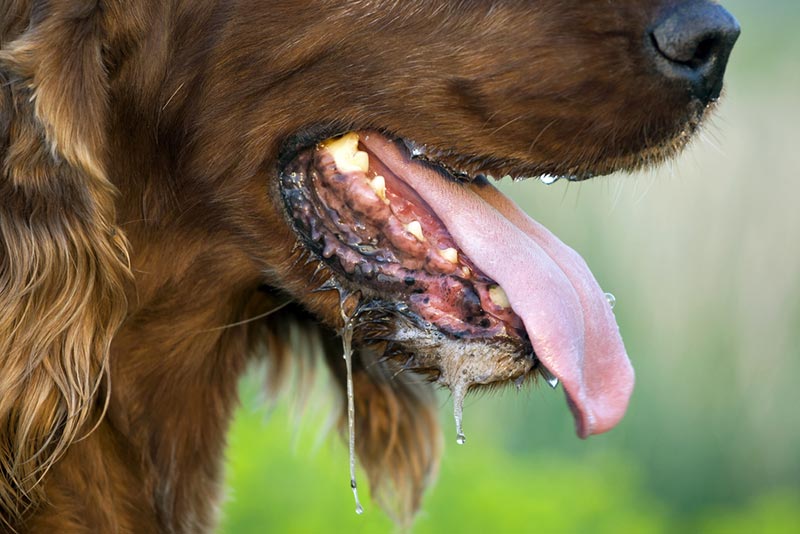
Considering how often we see our dog’s tongues, we all know that they’re always pink—unless you own a Chow Chow or Shar-Pei, in which case, their tongue is a blue-black color.
But if you notice that your dog’s tongue is red, you might be rather alarmed and rightly so. A red tongue can be a sign of a serious health condition, and you should see your vet straight away to rule out such issues.
In this article, we go over the reasons that a dog may have a red tongue. Some causes aren’t anything to worry about, but it’s still best to have it checked out.
The 10 Reasons Why a Dog’s Tongue Might Be Red
1. High Blood Pressure
One of the signs of high blood pressure, or hypertension, is a red tongue. High blood pressure occurs when the force of the dog’s blood starts pushing against the walls of their body’s blood vessels.
This can cause damage to internal organs, lead to kidney disease, and affect the brain or heart. Besides a red tongue, you may notice blood in the eyes, urine, or out of the nose.

2. Dehydration
Dehydrated dogs can get into serious trouble if they aren’t rehydrated quickly. Dehydration can lead to the heart, kidneys, and liver shutting down. Other signs of dehydration to look out for are:
To determine if your dog is dehydrated, you can perform the skin tent test. Gently pinch the loose skin between your dog’s shoulder blades, pull it upward, and then release it.
A dehydrated dog’s skin should spring back immediately. In contrast, a dehydrated dog’s skin will take longer to move back into place.
3. Overheating
An overheated dog suffering from heatstroke can have a red tongue from increased blood flow. A dog with heatstroke is in serious danger, as the body can quickly shut down. It can be fatal if the dog isn’t provided with water, shade, rest, and emergency medical help.
Signs of heatstroke include:

4. Carbon Monoxide Poisoning
We are all familiar with the dangers of carbon monoxide poisoning, and if a dog is near equipment leaking carbon monoxide, it can be fatal. They should be moved to a well-ventilated area immediately (outside would be best), and you should contact your vet. You also need to be examined if you have been exposed as well.
Other than a red tongue and mucous membranes, signs of carbon monoxide poisoning can include:
5. Inflammation of the Tongue
Stomatitis, or inflammation of the mouth, can include an inflamed tongue.
The lips, gums, floor, and roof of the mouth can all become inflamed. You’ll also notice a lack of appetite and an unkempt coat. One common cause of inflammation of the tongue and mouth is allergies, but it can also be linked to dental disease.

6. Mouth Trauma
There are several ways for a dog to experience an injury to the mouth. This can include chewing on something like a bone or stick and experiencing an electric shock from chewing wires.
This includes a condition sometimes called Burr Tongue, where dogs that have accumulated a lot of burrs in their coat from the Burdock plant, and cause trauma to their tongue when grooming.
7. Clotting Problem
Disruption to the clotting pathway can lead to spontaneous bleeding anywhere in the body, and a red tongue could be the result of bleeding from the tongue or inside the mouth.

8. Excitement or Stress
Sometimes, when a dog is really excited or upset, their pink tongue might become a deeper pink color. You should notice the color return to the usual pink once they’ve calmed down or cooled off.
9. Licked Something Red
Just like how our tongues can look bright red after eating a cherry slushie, a dog could lick something that transfers a red color to their tongue. Beetroot is a great one for this, and it can also turn their urine and feces red too!

10. Just the Color of Their Tongue
If your dog’s tongue has been a deep pink color for as long as you can remember, it could just be your dog’s natural tongue color.
Other Dog Tongue Colors
There are quite a number of reasons that a dog might have a red tongue, though there are a few other tongue colors to be aware of that might indicate a health problem.
Blue/Black
Chow Chows and Shar-Peis naturally have blue to black tongues. The Thai Ridgeback and the Eurasier can have spotted or solid blue-black tongues.
This is perfectly normal and nothing to worry about. If your dog has any blue-black spots on their tongue, it’s likely a kind of birthmark, or they may have Chow or Shar-Pei in their ancestry.

Blue or Purple
Blue or purple discoloration of the tongue is a sign of cyanosis, which is when a dog is struggling to oxygenate their tissues. The lack of oxygen, which can come from advanced heart or lung disease, can cause blue skin and mucous membranes. This condition needs immediate medical care.
This color might come and go, but even if it is only fleeting, you should contact your vet to make an urgent appointment.
White
A very pale pink or white tongue and gums can indicate anemia, which is a significant decrease in red blood cells. Anemia is a life-threatening condition that needs immediate veterinary care. Other signs are:
It could also be a sign of internal bleeding or very low blood pressure. Either way, a white tongue and gums needs emergency attention.
Yellow
A yellow tongue is a sign of liver problems, also known as jaundice or icterus, which occurs when a high bilirubin concentration (bile pigment) builds up. Jaundice can be caused by things like hepatitis, cirrhosis, and liver damage.
Yellow mucous membranes are the most common sign that there’s an issue with the liver, along with:
Icterus can also occur as a result of hemolysis (damaged red blood cells). Essentially, yellow mucous membranes are a sign of a serious problem and necessitate immediate attention from your vet.
Conclusion
Unless your dog has always had a dark pink tongue, or ate a red popsicle, a red tongue likely requires veterinary attention. The tongue is a great way to monitor your dog’s health, so it’s important to become familiar with its normal color.
A red tongue might not be a serious issue, but it could also be a sign of a serious problem that needs emergency care. It’s always best to prioritize your dog’s health and err on the side of caution; they are far too precious to take chances.
Featured Image Credit: WILLIAM F. CERMAK, Shutterstock








